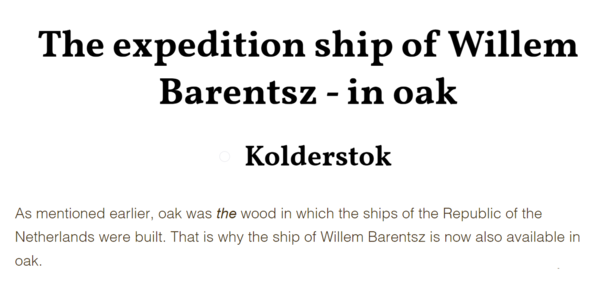-

Win a Free Custom Engraved Brass Coin!!!
As a way to introduce our brass coins to the community, we will raffle off a free coin during the month of August. Follow link ABOVE for instructions for entering.
-

PRE-ORDER SHIPS IN SCALE TODAY!
The beloved Ships in Scale Magazine is back and charting a new course for 2026!
Discover new skills, new techniques, and new inspirations in every issue.
NOTE THAT OUR FIRST ISSUE WILL BE JAN/FEB 2026
You are using an out of date browser. It may not display this or other websites correctly.
You should upgrade or use an alternative browser.
You should upgrade or use an alternative browser.
HIGH HOPES, WILD MEN AND THE DEVIL’S JAW - Willem Barentsz Kolderstok 1:50
- Joined
- Jan 9, 2020
- Messages
- 10,540
- Points
- 938

Hello Dear Friends
In his earlier posting @RDN1954 Johan said: "Almost invariably it pays to do your own research, if only to increase your understanding of the subject. Secondly, it's also worth to check and double check available information to confirm the accuracy of the information and, above all, for peace of mind."
However, all the research in the world would serve no purpose unless we assess our progress against the results of our research.
Sans for the rudder (and a few odds and ends like gun lid hinges, hawse holes etc.), the basic hull construction of my model has been completed. That means that the time has come to evaluate my build and see how it stacks up against the historical data that we know of and can prove. If I am honest (and I am going to be very honest in this posting), I think I have done well and I should be pleased with my progress thus far.
The question though is this: Do I have a good-looking model of the 1596 Willem Barentsz Expedition ship, or do I have a good-looking model ship? The only way of answering this is if I compare my model to the two interpretations of the WB ship that exist – those of Hoving and De Weerdt.
These findings will be posted in two instalments as there is a lot to absorb.
1. Front Canopy:
Both De Weerdt and Hoving agree on an open construction with no front or rear walls.
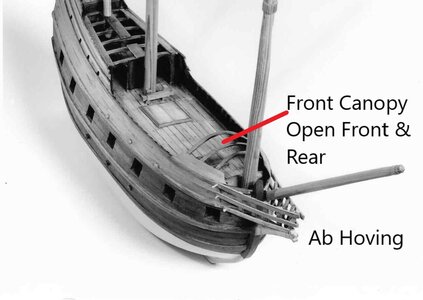
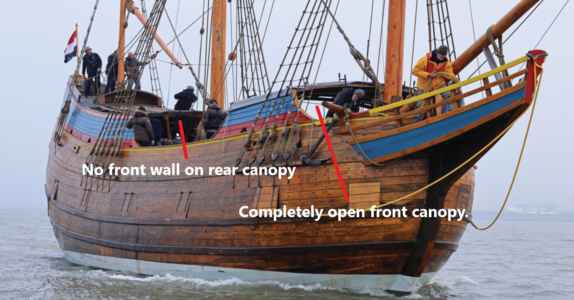
Verdict: My model does not conform to either Hoving or De Weerdt's interpretations.
2. Rear Canopy:
De Weerdt shows no front wall on the rear canopy at this stage of the construction. Whether that will be added later on in the build, I don’t know, but for now it is open. (See the same picture above).
On his plans, Hoving does show a front wall, but does not indicate any doors.
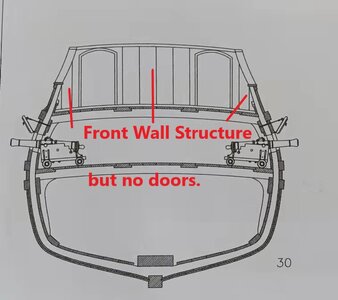
Verdict: My model is incorrect.
3. Number of gun ports
De Weerdt - like the Kolderstok interpretation - shows 6 gun ports, Hoving shows 7.
Verdict: My model conforms to the De Weerdt interpretation, but not to Hoving's.
4. Whipstaff vs Tiller
Hoving does not use a whipstaff (kolderstok) to control the rudder, but a tiller. As such there is also no helmsman's hut.
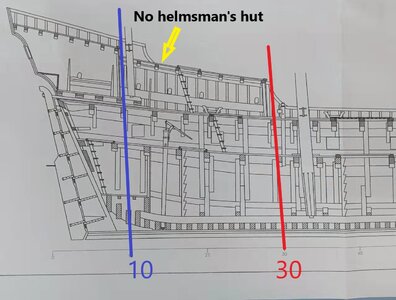
Hoving
Like the Kolderstok kit, De Weerdt uses a whipstaff (kolderstok) to control the rudder and therefore he also includes a helmsman’s hut. Without going into any discussion here as to who is right and wrong, I have many paintings and drawings which show the hut and to me it adds a great deal of aesthetic beauty.

De Weerdt
Verdict: My model conforms to the De Weerdt interpretation, but not to Hoving's.
5. The Windlass:
This issue has been discussed at length so I am not posting any pictures. De Weerdt has his windlass behind the front canopy, Hoving has his behind the foremast. My specific model thus conforms to De Weerdt’s drawings while the Kolderstok kit conforms to Hoving’s plans.
Verdict: My model conforms to the De Weerdt interpretation, but not to Hoving's.
So based on these 5 points (there are two more in the next posting) a prospective builder can thus bring his kit 100% in line with De Weerdt’s interpretation by:
- Leaving out the front and rear canopy walls and by scratch-building a windlass.
Should he decide to follow Hoving's interpretation, he would have to leave out the front and rear walls of the front canopy, build the rear canopy’s wall but leave out the doors, leave out the helmsman’s hut and simply inscribe a 7th gunport.
So the first 5 points of evaluation are all good news for prospective Willem Barentsz builders – the biggest challenge would probably be scratch-building the windlass.
For me though, my research has come too late – there is no way that I can start breaking out canopy walls as it simply involves too many related parts of the build. The only way that I can rectify this is by building a second WB.
In his earlier posting @RDN1954 Johan said: "Almost invariably it pays to do your own research, if only to increase your understanding of the subject. Secondly, it's also worth to check and double check available information to confirm the accuracy of the information and, above all, for peace of mind."
However, all the research in the world would serve no purpose unless we assess our progress against the results of our research.
Sans for the rudder (and a few odds and ends like gun lid hinges, hawse holes etc.), the basic hull construction of my model has been completed. That means that the time has come to evaluate my build and see how it stacks up against the historical data that we know of and can prove. If I am honest (and I am going to be very honest in this posting), I think I have done well and I should be pleased with my progress thus far.
The question though is this: Do I have a good-looking model of the 1596 Willem Barentsz Expedition ship, or do I have a good-looking model ship? The only way of answering this is if I compare my model to the two interpretations of the WB ship that exist – those of Hoving and De Weerdt.
These findings will be posted in two instalments as there is a lot to absorb.
1. Front Canopy:
Both De Weerdt and Hoving agree on an open construction with no front or rear walls.


Verdict: My model does not conform to either Hoving or De Weerdt's interpretations.
2. Rear Canopy:
De Weerdt shows no front wall on the rear canopy at this stage of the construction. Whether that will be added later on in the build, I don’t know, but for now it is open. (See the same picture above).
On his plans, Hoving does show a front wall, but does not indicate any doors.

Verdict: My model is incorrect.
3. Number of gun ports
De Weerdt - like the Kolderstok interpretation - shows 6 gun ports, Hoving shows 7.
Verdict: My model conforms to the De Weerdt interpretation, but not to Hoving's.
4. Whipstaff vs Tiller
Hoving does not use a whipstaff (kolderstok) to control the rudder, but a tiller. As such there is also no helmsman's hut.

Hoving
Like the Kolderstok kit, De Weerdt uses a whipstaff (kolderstok) to control the rudder and therefore he also includes a helmsman’s hut. Without going into any discussion here as to who is right and wrong, I have many paintings and drawings which show the hut and to me it adds a great deal of aesthetic beauty.

De Weerdt
Verdict: My model conforms to the De Weerdt interpretation, but not to Hoving's.
5. The Windlass:
This issue has been discussed at length so I am not posting any pictures. De Weerdt has his windlass behind the front canopy, Hoving has his behind the foremast. My specific model thus conforms to De Weerdt’s drawings while the Kolderstok kit conforms to Hoving’s plans.
Verdict: My model conforms to the De Weerdt interpretation, but not to Hoving's.
So based on these 5 points (there are two more in the next posting) a prospective builder can thus bring his kit 100% in line with De Weerdt’s interpretation by:
- Leaving out the front and rear canopy walls and by scratch-building a windlass.
Should he decide to follow Hoving's interpretation, he would have to leave out the front and rear walls of the front canopy, build the rear canopy’s wall but leave out the doors, leave out the helmsman’s hut and simply inscribe a 7th gunport.
So the first 5 points of evaluation are all good news for prospective Willem Barentsz builders – the biggest challenge would probably be scratch-building the windlass.
For me though, my research has come too late – there is no way that I can start breaking out canopy walls as it simply involves too many related parts of the build. The only way that I can rectify this is by building a second WB.
Last edited:
As always it’s fascinating reading your posts Heinrich. Lots of thought provoking statements and questions.
You ask “Do I have a good-looking model of the 1596 Willem Barentsz Expedition ship, or do I have a good-looking model ship?”. Without the ability to go back to 1596 you are, like most of us, reliant on in-depth research and interpretation. I would suggest you have an exquisite model of the 1596 Willem Barentsz Expedition ship.
You ask “Do I have a good-looking model of the 1596 Willem Barentsz Expedition ship, or do I have a good-looking model ship?”. Without the ability to go back to 1596 you are, like most of us, reliant on in-depth research and interpretation. I would suggest you have an exquisite model of the 1596 Willem Barentsz Expedition ship.
- Joined
- Jan 9, 2020
- Messages
- 10,540
- Points
- 938

Thank you very much for the support Roger. Based on the 5-points above, I have a chance of having a model of the 1596 WB Expedition Ship IF I remove the walls.As always it’s fascinating reading your posts Heinrich. Lots of thought provoking statements and questions.
You ask “Do I have a good-looking model of the 1596 Willem Barentsz Expedition ship, or do I have a good-looking model ship?”. Without the ability to go back to 1596 you are, like most of us, reliant on in-depth research and interpretation. I would suggest you have an exquisite model of the 1596 Willem Barentsz Expedition ship.
However, there is a second posting that is also to follow (once Hans and I have thrashed out the details) which might prove to be real challenge.
I am busy on the extra drawing, but didn't manage to finish it yesterday.
- Joined
- Aug 30, 2020
- Messages
- 676
- Points
- 353

It looks great to me as it has your thoughts in the build, it can't incorporate all the theories in one build so I think you should be very satisfied how it looks it's a beauty.Hello Dear Friends
In his earlier posting @RDN1954 Johan said: "Almost invariably it pays to do your own research, if only to increase your understanding of the subject. Secondly, it's also worth to check and double check available information to confirm the accuracy of the information and, above all, for peace of mind."
However, all the research in the world would serve no purpose unless we assess our progress against the results of our research.
Sans for the rudder (and a few odds and ends like gun lid hinges, hawse holes etc.), the basic hull construction of my model has been completed. That means that the time has come to evaluate my build and see how it stacks up against the historical data that we know of and can prove. If I am honest (and I am going to be very honest in this posting), I think I have done well and I should be pleased with my progress thus far.
The question though is this: Do I have a good-looking model of the 1596 Willem Barentsz Expedition ship, or do I have a good-looking model ship? The only way of answering this is if I compare my model to the two interpretations of the WB ship that exist – those of Hoving and De Weerdt.
These findings will be posted in two instalments as there is a lot to absorb.
1. Front Canopy:
Both De Weerdt and Hoving agree on an open construction with no front or rear walls.
View attachment 305505
View attachment 305506
Verdict: My model does not conform to either Hoving or De Weerdt's interpretations.
2. Rear Canopy:
De Weerdt shows no front wall on the rear canopy at this stage of the construction. Whether that will be added later on in the build, I don’t know, but for now it is open. (See the same picture above).
On his plans, Hoving does show a front wall, but does not indicate any doors.
View attachment 305507
Verdict: My model is incorrect.
3. Number of gun ports
De Weerdt - like the Kolderstok interpretation - shows 6 gun ports, Hoving shows 7.
Verdict: My model conforms to the De Weerdt interpretation, but not to Hoving's.
4. Whipstaff vs Tiller
Hoving does not use a whipstaff (kolderstok) to control the rudder, but a tiller. As such there is also no helmsman's hut.
View attachment 305508
Hoving
Like the Kolderstok kit, De Weerdt uses a whipstaff (kolderstok) to control the rudder and therefore he also includes a helmsman’s hut. Without going into any discussion here as to who is right and wrong, I have many paintings and drawings which show the hut and to me it adds a great deal of aesthetic beauty.
View attachment 305509
De Weerdt
Verdict: My model conforms to the De Weerdt interpretation, but not to Hoving's.
5. The Windlass:
This issue has been discussed at length so I am not posting any pictures. De Weerdt has his windlass behind the front canopy, Hoving has his behind the foremast. My specific model thus conforms to De Weerdt’s drawings while the Kolderstok kit conforms to Hoving’s plans.
Verdict: My model conforms to the De Weerdt interpretation, but not to Hoving's.
So based on these 5 points (there are two more in the next posting) a prospective builder can thus bring his kit 100% in line with De Weerdt’s interpretation by:
- Leaving out the front and rear canopy walls and by scratch-building a windlass.
Should he decide to follow Hoving's interpretation, he would have to leave out the front and rear walls of the front canopy, build the rear canopy’s wall but leave out the doors, leave out the helmsman’s hut and simply inscribe a 7th gunport.
So the first 5 points of evaluation are all good news for prospective Willem Barentsz builders – the biggest challenge would probably be scratch-building the windlass.
For me though, my research has come too late – there is no way that I can start breaking out canopy walls as it simply involves too many related parts of the build. The only way that I can rectify this is by building a second WB.
- Joined
- Jan 9, 2020
- Messages
- 10,540
- Points
- 938

No worries Hans. Take your time - that is a crucial one!I am busy on the extra drawing, but didn't manage to finish it yesterday.
- Joined
- Jan 9, 2020
- Messages
- 10,540
- Points
- 938

Richie I really appreciate your thoughts and you are probably right. In practice it would be well-nigh impossible to incorporate all theories in one build. However, I do believe that if a builder decides beforehand which interpretation he is going to follow, he can incorporate all the theories relevant to that interpretation in his build - in other words, he would be able to build a 100% correct Hoving-model or a 100% correct De Weerdt model.It looks great to me as it has your thoughts in the build, it can't incorporate all the theories in one build so I think you should be very satisfied how it looks it's a beauty.
That is, provided Hans and I can sort out what we are addressing now. And that is what is so great about working with a kit designer who himself is a model builder and enthusiast.
Hello Heinrich!
I feel like I am witnessing a prelude to the building of a Hoving version of the Willem Barentsz in Oak!
- Joined
- Jan 9, 2020
- Messages
- 10,540
- Points
- 938

Hello DanielHello Heinrich!
I feel like I am witnessing a prelude to the building of a Hoving version of the Willem Barentsz in Oak!
You are definitely witnessing the prelude to something! What it is though, I can't tell you right now - not because of any secrecy, but simply because I have no idea yet.
I will, however, lay all cards on the table - probably tonight.
Wow, that was a lot to absorb Heinrich. Great analysis indeed, although if I could be that introspective of my work I wonder if I would even get to install the first plank!Hello Dear Friends
In his earlier posting @RDN1954 Johan said: "Almost invariably it pays to do your own research, if only to increase your understanding of the subject. Secondly, it's also worth to check and double check available information to confirm the accuracy of the information and, above all, for peace of mind."
However, all the research in the world would serve no purpose unless we assess our progress against the results of our research.
Sans for the rudder (and a few odds and ends like gun lid hinges, hawse holes etc.), the basic hull construction of my model has been completed. That means that the time has come to evaluate my build and see how it stacks up against the historical data that we know of and can prove. If I am honest (and I am going to be very honest in this posting), I think I have done well and I should be pleased with my progress thus far.
The question though is this: Do I have a good-looking model of the 1596 Willem Barentsz Expedition ship, or do I have a good-looking model ship? The only way of answering this is if I compare my model to the two interpretations of the WB ship that exist – those of Hoving and De Weerdt.
These findings will be posted in two instalments as there is a lot to absorb.
1. Front Canopy:
Both De Weerdt and Hoving agree on an open construction with no front or rear walls.
View attachment 305505
View attachment 305506
Verdict: My model does not conform to either Hoving or De Weerdt's interpretations.
2. Rear Canopy:
De Weerdt shows no front wall on the rear canopy at this stage of the construction. Whether that will be added later on in the build, I don’t know, but for now it is open. (See the same picture above).
On his plans, Hoving does show a front wall, but does not indicate any doors.
View attachment 305507
Verdict: My model is incorrect.
3. Number of gun ports
De Weerdt - like the Kolderstok interpretation - shows 6 gun ports, Hoving shows 7.
Verdict: My model conforms to the De Weerdt interpretation, but not to Hoving's.
4. Whipstaff vs Tiller
Hoving does not use a whipstaff (kolderstok) to control the rudder, but a tiller. As such there is also no helmsman's hut.
View attachment 305508
Hoving
Like the Kolderstok kit, De Weerdt uses a whipstaff (kolderstok) to control the rudder and therefore he also includes a helmsman’s hut. Without going into any discussion here as to who is right and wrong, I have many paintings and drawings which show the hut and to me it adds a great deal of aesthetic beauty.
View attachment 305509
De Weerdt
Verdict: My model conforms to the De Weerdt interpretation, but not to Hoving's.
5. The Windlass:
This issue has been discussed at length so I am not posting any pictures. De Weerdt has his windlass behind the front canopy, Hoving has his behind the foremast. My specific model thus conforms to De Weerdt’s drawings while the Kolderstok kit conforms to Hoving’s plans.
Verdict: My model conforms to the De Weerdt interpretation, but not to Hoving's.
So based on these 5 points (there are two more in the next posting) a prospective builder can thus bring his kit 100% in line with De Weerdt’s interpretation by:
- Leaving out the front and rear canopy walls and by scratch-building a windlass.
Should he decide to follow Hoving's interpretation, he would have to leave out the front and rear walls of the front canopy, build the rear canopy’s wall but leave out the doors, leave out the helmsman’s hut and simply inscribe a 7th gunport.
So the first 5 points of evaluation are all good news for prospective Willem Barentsz builders – the biggest challenge would probably be scratch-building the windlass.
For me though, my research has come too late – there is no way that I can start breaking out canopy walls as it simply involves too many related parts of the build. The only way that I can rectify this is by building a second WB.
I certainly it doesn't come to this though?
The only way that I can rectify this is by building a second WB
Great research all the same, and a very interesting read

- Mark
- Joined
- Aug 30, 2020
- Messages
- 676
- Points
- 353

Yes that's is more what I am getting at, probably needed to say all the "different" theories.in other words, he would be able to build a 100% correct Hoving-model or a 100% correct De Weerdt model.
Sounds interesting what's coming up next, intriguing.
- Joined
- Jan 9, 2020
- Messages
- 10,540
- Points
- 938

Thank you for the support and the comments Mark! Normally, I am not nearly as introspective as this, but something strange happened when I started building this model. So often we hear that it is impossible to build a model that is historically correct (I have said it myself) until I asked myself why not?Wow, that was a lot to absorb Heinrich. Great analysis indeed, although if I could be that introspective of my work I wonder if I would even get to install the first plank!
I certainly it doesn't come to this though?
Great research all the same, and a very interesting read
- Mark
Ever since then I have simply made a policy decision. Do research until I find a solution that is logical to me and do not compromise until I have found that solution. And if that means, start all over, well ... then I start all over!
- Joined
- Jan 9, 2020
- Messages
- 10,540
- Points
- 938

To me it is most intriguing Richie - although, after my next posting you may all believe I really have to be certified.Yes that's is more what I am getting at, probably needed to say all the "different" theories.
Sounds interesting what's coming up next, intriguing.

Maybe not certifiable but are we heading towards obsession. Remember this is just a hobby. (I think) Do we need to call the Admiral for an intervention.To me it is most intriguing Richie - although, after my next posting you may all believe I really have to be certified.
- Joined
- Jan 9, 2020
- Messages
- 10,540
- Points
- 938

Ron, in the past, I might have objected to the word "obsession", but now I'm quite comfortable with it. All I want to do is to build a ship that - to my knowledge - is correct. In order to do that I am willing to go the extra mile.Maybe not certifiable but are we heading towards obsession. Remember this is just a hobby. (I think) Do we need to call the Admiral for an intervention.
The Admiral might surprise you. The Chinese have a saying when something is nor good nor bad - translated it means "so-so". She does not like "so-so".
I agree. I don’t like so-so either. That goes along with “That looks about right” not something I’m comfortable with. To me it means one is settling for something less.Ron, in the past, I might have objected to the word "obsession", but now I'm quite comfortable with it. All I want to do is to build a ship that - to my knowledge - is correct. In order to do that I am willing to go the extra mile.
The Admiral might surprise you. The Chinese have a saying when something is nor good nor bad - translated it means "so-so". She does not like "so-so".
- Joined
- Jan 9, 2020
- Messages
- 10,540
- Points
- 938

Exactly Ron! Settling for less is something I have maybe done too often in my life - this is one instance where I am simply not going to.I agree. I don’t like so-so either. That goes along with “That looks about right” not something I’m comfortable with. To me it means one is settling for something less.
- Joined
- Jan 9, 2020
- Messages
- 10,540
- Points
- 938

Hello Everyone.
I am sure that you are getting tired of all this research and technical talk - but I promise - tonight is the second-last research posting. After this all that remains is the final conclusion and decision.
You know how one sometimes looks at something without actually comprehending what it is that you are seeing? Well that is what happened to me. For goodness knows how long, I have been comparing Hoving and De Weerdt's plans to that of Kolderstok and to my model and never picked up on a glaring difference. Until it finally struck home!
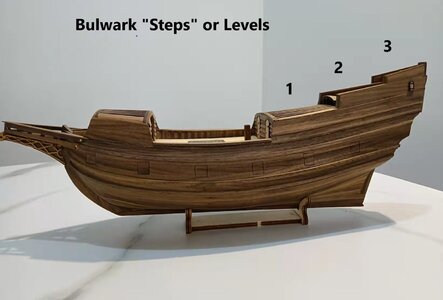
Notice the three "steps" or "levels" that my rear bulwarks follow in their build-up towards the stern.
Now look at this:
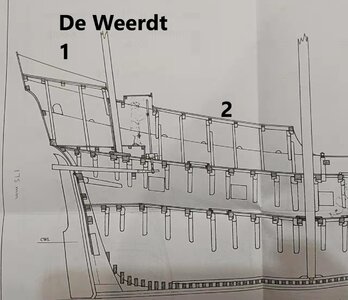
De Weerdt
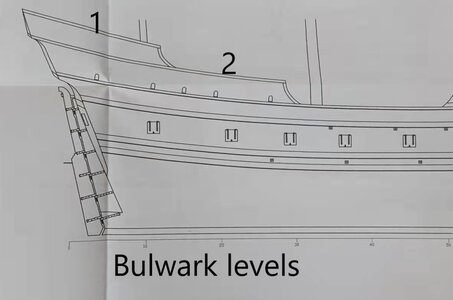
Hoving
So - what is amiss here? I delved back into the books and there De Weerdt very clearly stipulated: The high build-up at the stern probably housed a cabin of sorts.” He subsequently goes on to say that in all likelihood it would have been the cabin of Willem Barentsz and/or Jacob Heemskerck.
All good, but how does the presence of the cabin influence the number of steps in the rear bulwarks? Easy - the cabin has to have a floor and a roof - the latter determined by the lower (overloop or orlop) deck and the roof by one of the upper-decks. If the model does not have the captain's cabin, its deck layout and the subsequent bulwark heights will be different from one which has to make provision for a cabin. So why then did Hans not include the cabin? For the simple reason that the cabin will virtually be invisible.
So let me show you what the cabin looks like: (By the way, Hoving and De Weerdt are 100% in agreement with regards to its location and existence.)
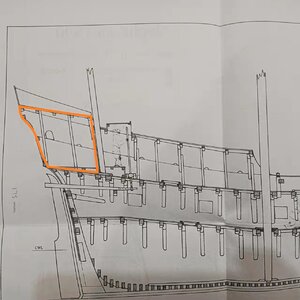
Cabin marked in orange on the De Weerdt plans. Note the helmsman in front of the cabin in his helmsman's hut. You can also clearly see the whipstaff-idea that De Weerdt and Kolderstok subscribe to.
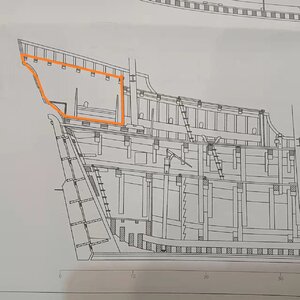
Cabin marked in orange on Hoving's plan. Notice the absence of helmsman's hut due to the fact that Hoving believed the Willem Barentsz used a tiller and not a whipstaff to steer the rudder.
The following pictures show the construction of the cabin according to Hoving's plans. The model builder was Constant Willems on Modelbouwforum.
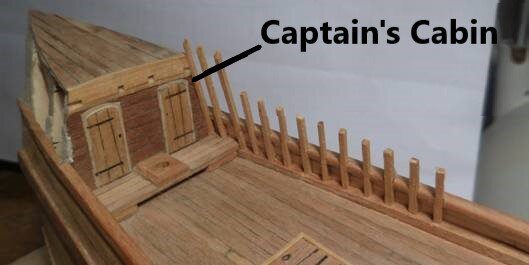
The captain’s cabin – right behind the mizzen mast.
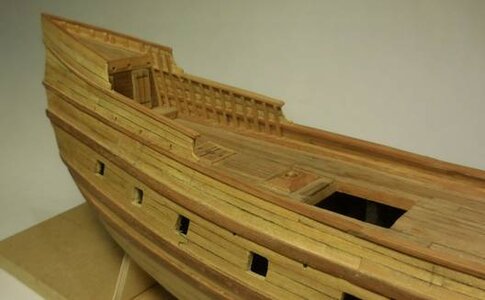
With the build-up of the bulwarks completed at the stern, that is what it looks like.
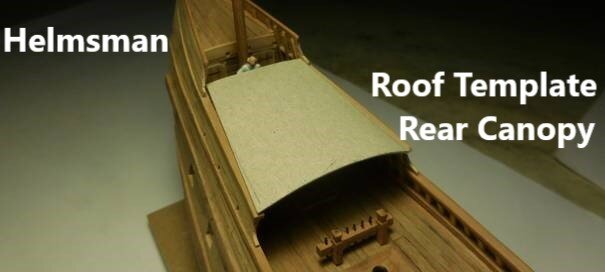
And that is the position that the helmsman will assume behind the rear canopy - exposed to all the elements. (Wild Men of Steel)
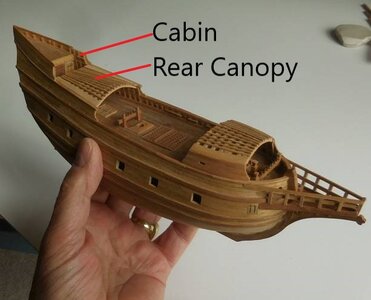
On the completed model that is what will be visible of the captain's cabin. Also note the complete absence of any front or rear walls on the canopy.
The next two pictures show the De Weerdt configuration.
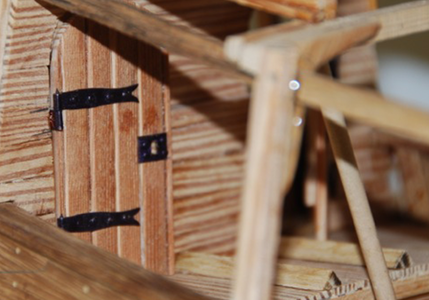
Captain's Cabin. The roof beams that are just visible in the picture are those of the rear canopy.
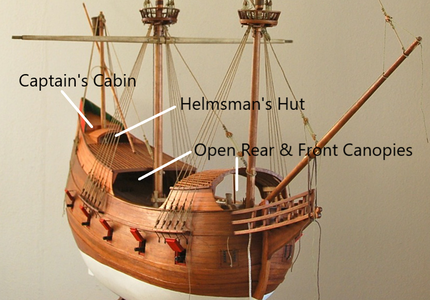
Final configuration of De Weerdt on the Koos Weestra model. As you will see there is almost nothing of the cabin visible, but with the open rear canopy and possible addition of LED Lighting to the model, it should create a nice display - not nearly as aesthetically pleasing as my model is with its closed front wall and doors - but correct.
So, just as I laid my thoughts on the table for you guys, just so I laid them on the table for Hans - plus a few other suggestions that I will still get to at a later stage. And within 24-hours I had an amended line drawing of the @Kolderstok plans! This is not even a case of service anymore - it is a case of friendship!
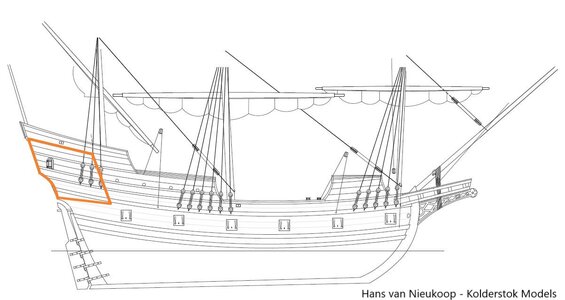
Now it's just a question of thrashing out a few details with Hans and hopefully I can make an announcement to the final configuration soon!
That is all for tonight - until the next instalment.
I am sure that you are getting tired of all this research and technical talk - but I promise - tonight is the second-last research posting. After this all that remains is the final conclusion and decision.
You know how one sometimes looks at something without actually comprehending what it is that you are seeing? Well that is what happened to me. For goodness knows how long, I have been comparing Hoving and De Weerdt's plans to that of Kolderstok and to my model and never picked up on a glaring difference. Until it finally struck home!

Notice the three "steps" or "levels" that my rear bulwarks follow in their build-up towards the stern.
Now look at this:

De Weerdt

Hoving
So - what is amiss here? I delved back into the books and there De Weerdt very clearly stipulated: The high build-up at the stern probably housed a cabin of sorts.” He subsequently goes on to say that in all likelihood it would have been the cabin of Willem Barentsz and/or Jacob Heemskerck.
All good, but how does the presence of the cabin influence the number of steps in the rear bulwarks? Easy - the cabin has to have a floor and a roof - the latter determined by the lower (overloop or orlop) deck and the roof by one of the upper-decks. If the model does not have the captain's cabin, its deck layout and the subsequent bulwark heights will be different from one which has to make provision for a cabin. So why then did Hans not include the cabin? For the simple reason that the cabin will virtually be invisible.
So let me show you what the cabin looks like: (By the way, Hoving and De Weerdt are 100% in agreement with regards to its location and existence.)

Cabin marked in orange on the De Weerdt plans. Note the helmsman in front of the cabin in his helmsman's hut. You can also clearly see the whipstaff-idea that De Weerdt and Kolderstok subscribe to.

Cabin marked in orange on Hoving's plan. Notice the absence of helmsman's hut due to the fact that Hoving believed the Willem Barentsz used a tiller and not a whipstaff to steer the rudder.
The following pictures show the construction of the cabin according to Hoving's plans. The model builder was Constant Willems on Modelbouwforum.

The captain’s cabin – right behind the mizzen mast.

With the build-up of the bulwarks completed at the stern, that is what it looks like.

And that is the position that the helmsman will assume behind the rear canopy - exposed to all the elements. (Wild Men of Steel)

On the completed model that is what will be visible of the captain's cabin. Also note the complete absence of any front or rear walls on the canopy.
The next two pictures show the De Weerdt configuration.

Captain's Cabin. The roof beams that are just visible in the picture are those of the rear canopy.

Final configuration of De Weerdt on the Koos Weestra model. As you will see there is almost nothing of the cabin visible, but with the open rear canopy and possible addition of LED Lighting to the model, it should create a nice display - not nearly as aesthetically pleasing as my model is with its closed front wall and doors - but correct.
So, just as I laid my thoughts on the table for you guys, just so I laid them on the table for Hans - plus a few other suggestions that I will still get to at a later stage. And within 24-hours I had an amended line drawing of the @Kolderstok plans! This is not even a case of service anymore - it is a case of friendship!

Now it's just a question of thrashing out a few details with Hans and hopefully I can make an announcement to the final configuration soon!
That is all for tonight - until the next instalment.
Oh wow. To date i’ve struggled to conform and place the first plank on my WB build. Your build log and Kolderstok’s plans and instructions are my “textbook“. Your research and comparison to the known, the interpreted and assumed facts is amazing. Regardless of the historical differences you’ve noted in your incredible post, your build can be classified as an extraordinarily crafted model.


